Creating Conversation
A Comparison of English and Turkish Phrase Structures
by Emily Towery

This paper compares the structure of the English and the Turkish languages. After a brief introduction to linguistic concepts, the paper works through, first, a basic English analysis under the lens of generative syntax and, then, a lengthier process developing a working grammar for Turkish. Ultimately, the two are compared to emphasize that despite surface differences, the languages are connected at a deeper level.
Keywords: Linguistics, Syntax, Generative Grammar, Phrase Structure, Word Order
Most developments in the average person’s life rely on conversation to proceed successfully. A person is unable to get a job without first interviewing for it. Any romantic encounter would be futile if neither person could express how they felt. A teacher would struggle to enlighten their students if none of the information could be vocalized. Yet, the ability to string together words successfully to create a meaningful, understandable sentence is taken for granted after the first years of life, aside from the occasional English class. Even then, the perceived misplacement of a comma is unrelated to the grammar that linguists study.
In a broad sense, linguistics is devoted to shining a light on the intricacies of language. Linguists focus on the day-to-day use of language and how it grows and changes within society, not the overly formalized rules and regulations laid out by English teachers everywhere. Syntax is the subfield of linguistics that focuses on the structure and rules of how sentences can be formed in a language which creates the linguistic version of a grammar, starting from the development of language during childhood, as a way to show inherent commonalities amongst all languages (Freidin 2012).
In the field of syntax, linguists have come up with generative grammar as a computational device that maps the lexicon of a language with the paired phrase structure rules that then create linguistic expressions (Freidin 2012). These phrase structure rules are perceived and then internalized as a child acquires a language and creates a grammar regulating their speech. Linguists consider a sentence grammatical when it is generated from a person’s mental lexicon—which includes every word whose meaning they are familiar with, as well as their internalized phrase structure rules—and it sounds like something that a native speaker would naturally utter (Freidin 2012). Using this theory and a set of grammatical and ungrammatical Turkish sentences, I will use the syntax lens to walk through the process of creating a grammar for Turkish and compare it to a partial grammar for native English speakers in an effort to prove that surface-level differences can hide structural similarities among languages.
First, I will discuss the general differences of the languages we are analyzing. On a broad scale, the languages have different ordering when it comes to the subject, verb, and objects of a sentence. English is an SVO language, which has the subject of the sentence occur first, then the verb, and then the object. Turkish, however, is an SOV language. This type of language has the object of a sentence placed before the verb, which I will illustrate in the rules we discern for this language.
English Phrase Structures
Before delving into the structure of Turkish, I will go over the basic phrase structure rules for English, derived in depth in Wolfman (this issue).
A sentence (S) can be created from as little as two parts, as shown in the sentence “Mary ran.” These parts consist of the noun phrase (NP), which holds the subject, Mary, and the verb phrase (VP), which holds the information about the verb, ran, in a sentence. The only required parts of an NP or VP are the noun or verb, respectively. Every other addition is optional and therefore will be contained in parentheses in the English Phrase Structure rules to illustrate this lack of necessity. We can alter the sentence to “A very pretty girl ran” to demonstrate a more complicated NP, with the addition of both a determiner, a; an adjective, pretty; and an intensifier very modifying our adjective pretty. Because our intensifier applies to an adjective, and any adjective could optionally allow for an included intensifier, we can add a new adjective phrase (AP) rule to hold the optional intensifier and the adjective. With the introduction of our new AP and determiner together, we can see that both elements can coexist; we can also see how those elements need to be ordered in our NP rule, as “very pretty a girl ran” would be ungrammatical. Next, we can show that there can be a prepositional phrase (PP) included in the NP with the example sentence “A pretty girl with red shoes ran.” The PP is the only element put after the noun, and an NP could grammatically include multiple descriptive prepositions. Next we can begin focusing on our VP with the sentence “Mary took the car to the store,” which contains a more complex VP. This sentence includes an NP directly after the verb, and a PP following that. An alternative structure for the VP is demonstrated in the sentence “Mary is fast,” which has an adjective following the verb. Finally, we can prove they are all able to coexist with the sentence “Mary painted the house green with a brush,” which combines our three optional elements (NP, AP and PP) and shows that the required ordering of the elements is NP-VP-PP.
(1)
S → NP VP
NP → (D) (AP) N
VP → V (NP) (AP) (PP)
PP → P NP
AP → (int) A
Turkish Phrase Structures
Now that we have a background for our phrase structure rules in English, I will extend the practice to begin accounting for Turkish grammar. Using various data sets, I will start with the basics and then explore new elements of the Turkish grammar. As I accumulate data and reconsider rules, I will eventually create a comprehensive series of phrase structure rules.
First, we will list a lexicon of the words we will be using to create an NP rule:
| Noun | maymun ‘monkey’, muz ‘banana’, araba ‘car’ |
| Adjective | mutlu ‘happy’, lezzetli ‘delicious’, pahah ‘expensive’, güzel ‘beautiful’ |
| Determiner | bu ‘this’, şu ‘this/that’, o ‘that’ |
Using this lexicon, we can create NPs that illustrate our rule. Just as in English and Indonesian, the most basic NP consists solely of a noun, showing that the noun is the only required element in an NP.
(2)
(a) maymun
money
‘the monkey’
As with English, we can grow our NP by adding both adjectives and determiners. The coexistence of the elements is possible, and if both are present the determiner must be placed before the adjective. Our ungrammatical sentences in (d-h) serve to emphasize the necessary ordering of the elements.
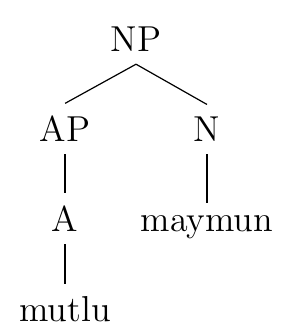
(b) mutlu maymun
happy monkey
‘the happy monkey’
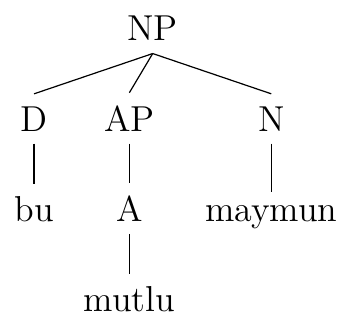
(c) bu mutlu maymun
This happy monkey
‘this happy monkey’
(d) *bu maymun mutlu
This monkey happy
Intended: ‘this happy monkey’
(e) *maymun mutlu bu
Monkey happy the
Intended: ‘this happy monkey’
(f) *mutlu bu maymun
Happy the monkey
Intended: ‘this happy monkey’
We also can see that multiple determiners are not an option for Turkish, as shown in (2g).
(g) *bu şu maymu
This the monkey
Intended: ‘this the monkey’
In the data set we are basing our analysis on, there is no data mentioning the possibility of two adjectives coexisting in an NP, so we will assume that this is impossible in our grammar. To account for the above phrases and restrictions, I propose the following rule:
(3)
To summarize, there is a required noun that occurs after all other optional elements, which consist of one possible determiner and one possible adjective, in that order.
NP → (D) (A) N
Using this rule, some other possible noun phrases generated by Turkish would be:
(4a)
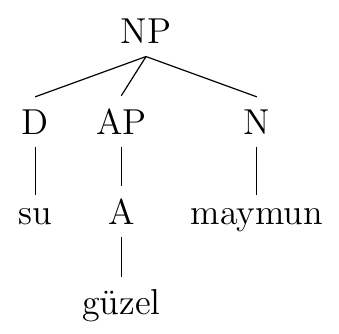
şu güzel maymun
this/that beautiful monkey
‘This/that beautiful monkey’
(4b)
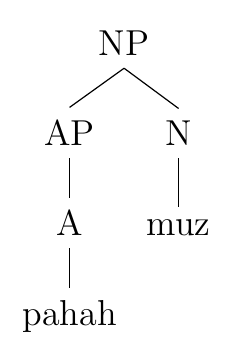
pahalı muz
expensive banana
‘The expensive banana’
The Turkish noun phrase rule looks more like what we know from English phrase structure rules than from the Indonesian noun phrase rule. Indonesian is a head-initial language, which means the main element in the phrase occurs first, while Turkish is head-final and English is mixed-headed. All three languages are also similar in that they can contain only one determiner, and the only required element in the phrase is the noun.
Next, we will introduce a new intensifier category to be considered within our NP rule. First we must add an intensifier category (Int) to our lexicon and contribute new words to our existing categories. Our updated lexicon is as follows:
| Noun | maymun ‘monkey’, muz ‘banana’, araba ‘car’, kiz ‘girl’ |
| Adjective | mutlu ‘happy’, lezzetli ‘delicious’, pahah ‘expensive’, güzel ‘beautiful’ |
| Determiner | bu ‘this’, şu ‘this/that’, o ‘that’ |
| Int | çok ‘very’, gayet ‘quite’, pek ‘too’ |
I will specifically reference the following sentences during my discussion:
(5)
(a) şu gayet güzel vkız
this/that quite beautiful girl
‘this/that quite beautiful girl’
(b) pek pahalı araba
too expensive car
‘the too expensive car’
(c) *bu çok maymun
This very monkey
Intended: ‘this very monkey’
(d) *bu mutlu çok maymun
A happy very monkey
Intended: ‘this happy very monkey’
(e) *çok bu mutlu maymun
Very a happy monkey
Intended: ‘very the happy monkey’
We start with the addition of the intensifier in sentence (5a) after the determiner and before the adjective. This format is followed in (5b), as well, supporting the idea of adding an intensifier element to the NP rule that optionally occurs after the determiner and before the adjective elements if they are present. The format is supported by (5d) and (5e) because they are both switched around and therefore ungrammatical. The expected rule would then be the following:
(f)
NP → (D) (Int) (Adj) N
This rule implies that the intensifier works the same way as the determiner and adjective. However, (5c) refutes the previously theorized NP rule because it has a determiner and an intensifier element in the proper order but is still ungrammatical. This observation suggests a connection between the intensifier and the adjective; the intensifier cannot occur in the NP unless it has an adjective to modify. Because there is no way to account for this requirement directly within the NP, it leads to the creation of a new element, an adjective hrase (AP), which is its own constituent. The AP would consist of a required adjective and optional Int element and can be illustrated as
(g)
NP → (D) (AP) N
AP → (Int) Adj
Accordingly, these updated rules can be illustrated with constituent trees for our previously discussed NPs.
(5a)
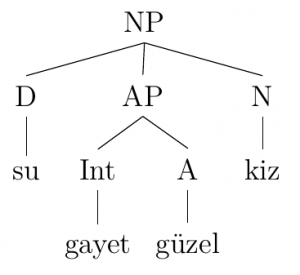
(5b)
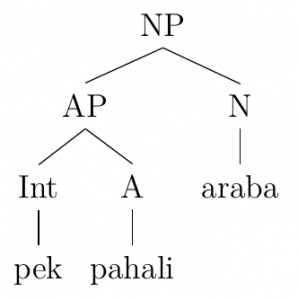
These updates account for the fact that an intensifier can only occur in an NP if it is connected to an adjective, but the whole phrase is still optional within the NP.
Next, we will introduce a new determiner, bir (‘a’), that works differently compared to our previous discussed determiners.
(6)
(a) çok mutlu bir maymun
Very happy a monkey
‘a very happy monkey’
(b) bir muz
a banana
‘a banana’
(c) pek pahalı bir araba
too expensive a car
‘a too expensive car’
When describing singular nouns, bir is optional, as evident from the previous grammatical sentences which did not include it. It appears, however, in a different spot in the NP and therefore must be approached differently. In (6a), (6b) and (6c), bir occurs directly before the noun it describes, regardless of the presence of other elements in the NP.
(d) *bir mutlu maymun
A happy monkey
Intended: ‘a happy monkey’
(e) *bir çok güzel kız
A very beautiful girl
Intended: ‘a very beautiful girl’
Examples (6d) and (6e) place bir according to our original NP rule, at the beginning of the NP, but these sentences are ungrammatical, proving the bir has inherent differences in use from other Turkish determiners.
(f) *şu gayet bir pahalı maymun
This/that quite a expensive monkey
(this/that quite a expensive monkey)
Meanwhile, sentence (6f) is the only instance of two coexisting determiners, which could be ungrammatical. At the same time, the sentence also has bir splitting the Int and adjective in the AP, which could also be the reason for the ungrammaticality. Therefore, it is unclear whether we can have two coexisting determiners or not, assuming one of them is a correctly used bir. Due to the nature of determiners in other languages, I am going to represent them as though they cannot coexist, though we would need to validate this rule through further data. To establish this rule, then, we can create a new category of determiners called the indefinite determiners (DInd) and alter our NP phrase structure rule to account for them. We can represent this rule as
(g)

This rule shows that speakers of the language have the option either to put a definite article before the AP or to put an indefinite article after the AP, if an AP is used.
Turkish Sentence Structures
Next, we will investigate full Turkish sentences. One thing of interest to note before we begin the analysis is the Turkish case system that its nouns exhibit.Each ending alters the noun, but for the purpose of finding the phrase structure rules for Turkish we will pass over this system and return to it in the future. We will specifically reference the following sentences when analyzing Turkish sentence structure:
(7)
(a) mutlu maymun gülüyor
Happy monkey laughing
‘the happy monkey is laughing’
(b) maymun muzu istiyor
Monkey banana wants
‘the monkey wants the banana’
Each sentence in Turkish, as of now, consists of an NP and a VP. The NPs in the above sentences have already been accounted for, so we will begin inspecting the VPs. As shown by sentence (7a), the only required element of the VP is the verb, with the following sentences providing restrictions of optional additions. Sentence (7b) provides a grammatical example with an NP occurring before the verb, representing the object of the verb.
(c) maymun muz ile oynuyor
monkey banana with playing
‘the monkey is playing with the banana’
(d) güzel kız o çirkin maymun ile konuşuyor
beautiful girl that ugly monkey with talking
‘the beautiful girl is talking with that ugly monkey’
(e) güzel kız bir maymun sarhoş gibi davranıyor
beautiful girl a monkey drunken like behaving
‘the beautiful girl is behaving like a drunken monkey’
Similarly, (7c), (7d) and (7e) provide examples of a PP occurring before the verb. Within the PP, we see that the noun occurs before the preposition. Therefore, we can define the rule for a PP as follows:
(f)
PP → NP P
In the VP, we now see that the PP also occurs before the verb, and both the PP and NP occur independently from each other. That is, they do not depend on the each other to appear.
(g) maymun bir muz için ağaca çıkıyor
monkey a banana for tree climbing
‘the monkey is climbing the tree for a banana’
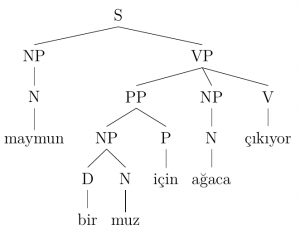
(h) güzel kız maymun için şarkıyı söylüyor
beautiful girl monkey for song singing
‘the beautiful girl is singing the song for the monkey’
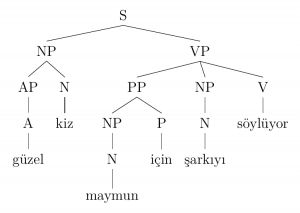
There is an example of them occurring together, however, in sentences (7g) and (7h). This proves that the order for NPs and PPs preceding the verb would be the PP first, followed by the NP, and then the verb. This leads to a new VP rule:
(i)
VP → (PP) (NP) V
(j) çok pahalı bir maymun o büyük ağaçtan düşüyor
very expensive a monkey that big tree-from falling
‘a very expensive monkey is falling from that big tree’
Sentence (6i) is an interesting case, as the N ağaçtan ‘tree’ has a suffix that is translated as a preposition in English. I do not believe this would cause us to need to alter our phrase structure rules. There could be phrases acting as prepositional phrases that do not explicitly contain a preposition, but, more straightforwardly, these nouns here fall into an NP category, with the suffixation accounted for by form rules (which ensure that words are inflected correctly depending on their position in the sentence or, more specifically, the verb they are complementing).
Finally, we can alter our overall sentence rule to account for our last data set.
(8)
(a) maymun mutlu
Monkey happy
‘the monkey is happy’
(b) muz masada
Banan table
‘the banana is on the table’
(c) o maymun gayet güzel bir hayvan
That monkey quite beautiful a animal
‘that monkey is a quite beautiful animal’
Sentence (8a) shows a possible sentence structure that has an NP followed by only an AP, proving that there are other options when creating a sentence aside from simply an NP and a VP. Like Indonesian, as laid out in Wolfman and Felt (this issue), Turkish appears to have a nonverbal predicate that can be used in proximity to the VP. Sentence (8b) reveals a continuation in the pattern, pairing the subject NP with a PP as the nonverbal predicate. Finally, sentence (8c) allows for an NP and another NP as the nonverbal predicate. This shows that our sentence phrase structure rule for Turkish can be formatted as follows:
(d)
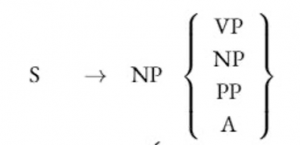
This final sentence rule modification gives us the following cohesive set of phrase structure rules, which can be compared to the English rules shown again for reference.
(9) Turkish
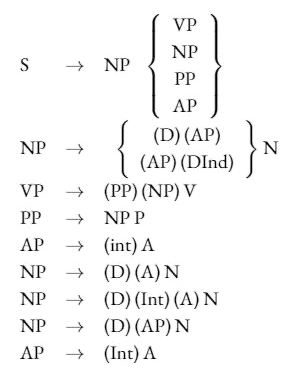
(10) English
S → NP VP
NP → (D) (AP) N
VP → V (NP) (AP) (PP)
PP → P NP
AP → (int) A
The most notable difference in the two languages when viewing the phrase structure rules comparatively seems to be the S rule. In both languages, a sentence must consist of two elements, the first of which must be an NP, and for English the second must be a VP. However, Turkish has a system that allows for the second element to be one of four options. The use of an NP with any second constituent other than a VP can be translated to English as having the verb is. Turkish does not have a direct translation of is; the linking verb element is not included but the function of combining subject and predicate is retained. The headedness of the two languages, which describes where the most important element of a phrase lies in relation to other elements, is also different. Turkish is head-final in its VP, NP, and PP rules, which means that the most important element of the phrase is at the end. English is mixed-headed. That is, the VP rule for English is head-initial, while the NP rule looks more head-final with the optional determiner and adjective preceding the head.[1]
English and Turkish have significant differences, including the presence of nonverbal predicates and the case system in Turkish, as well as differences in their word order typology. However, the two languages also share commonalities that come to light with the creation of phrase structure rules, specifically in their noun phrases. The ability to execute this comparison effectively is what allows linguists to create connections between seemingly unrelated languages by delving into the patterns and rules that are utilized in each language. These rules, in turn, give society the gift of conversation, which elevates our interpersonal interactions to a level above that of any other species.
Citation
Freidin, R. (2012). Syntax: basic concepts and applications. Cambridge: Cambridge Univ. Press.
Notes
[1] When we add a complement to the N, like of linguistics, as in the teacher of linguistics, we see that English NPs are not actually head-final. The PP-complement follows the N-head. In Turkish, the complement always precedes the head.
Acknowledgements: I would like to thank my generative syntax professor Dr. Vera Lee-Schoenfeld for introducing me to the topic of syntax, as well as offering her invaluable guidance and suggestions through the writing process.